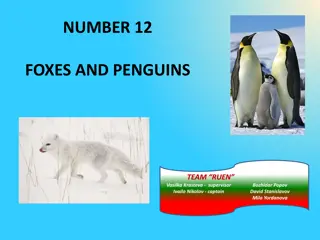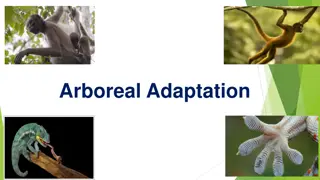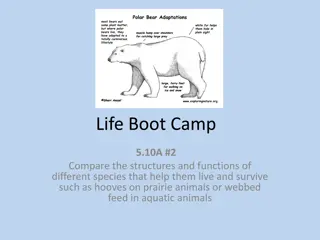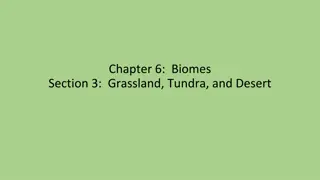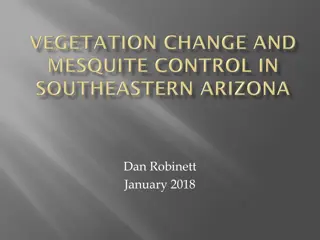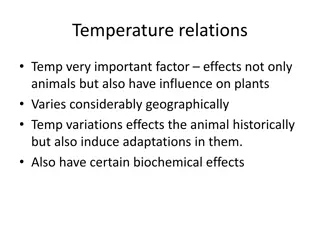Desert Adaptations: Animals and Habitat Survival
Habitats play a crucial role in the survival of animals, especially in harsh environments like deserts. Explore the unique adaptations of animals like camels and learn how they are perfectly suited to thrive in hot, arid conditions. Understanding these adaptations is key to appreciating the diversity of life on our planet.
Download Presentation

Please find below an Image/Link to download the presentation.
The content on the website is provided AS IS for your information and personal use only. It may not be sold, licensed, or shared on other websites without obtaining consent from the author. Download presentation by click this link. If you encounter any issues during the download, it is possible that the publisher has removed the file from their server.
E N D
Presentation Transcript
Monday 12thApril 2021 Desert adaptations A habitat is A desert habitat is a. Something that a person is addicted to doing. E.g smoking a. Cold, dry and arid. b. Hot, arid and empty. b. A place where an animal lives. c. Warm, wet and empty. c. How an animal looks. A desert has Which statement is true? a. Animals and plants such as meerkats, Cacti and scorpions. a. There are hardly any deserts in the world. b. The arctic and Antarctic are classed as deserts. c. It is always red hot in deserts b. No animals or plants. c. Animals such as Monkeys and camels.
KEYWORD ALERT! Adaptation In science this means how an animal suits its habitat. For example An orangutan lives in a rainforest with lots of trees to climb. It is suited to that environment because it has long arms to reach for trees and swing.
A habitat is a place where something lives. There are many different types of habitats: hot or cold big or small on land or in water STRETCH: Name some of the features of the habitat you have named. (e.g mountains, rivers, trees, plants, sand, mud, water, coral, houses) Name 5 different habitats. For example: A desert. Name 2 animals that live in one of the habitats you have mentioned
Learning Objectives: -State some adaptations of an animal from a desert environment. -Describe some adaptations of an animal from a desert environment. -Explain how these adaptations are important for surviving a desert habitat.
LO: State some adaptations of an animal from a desert environment Adaptations of a Camel Three rows of eyelashes. Thin, slot-like nostrils. Can consume up to 46 litres of water in one sitting. Thick fur on the top of their bodies; thin fur elsewhere. Can run up to 40mph in a sprint, or maintain 25mph for up to an hour. Large, flat feet.
LO: Describe some adaptations of an animal from a desert environment Three rows of eyelashes. Protection from sandstorms/strong winds.
LO: Describe some adaptations of an animal from a desert environment Thin, slot-like nostrils. Prevents sand from entering the body and damaging the lungs. It protects the breathing of the camel
Replenish means to fill something up again. Can consume up to 46 litres of water in one sitting. Water is scarce and this allows them to hydrate and replenish stored water quickly. This water gets stored as fat in the camels hump.
LO: Describe some adaptations of an animal from a desert environment Thick fur on the top of their bodies; thin fur elsewhere. Thick fur provides shade, stopping the camel getting sunburn and thin fur stops the camel over heating.
LO: Describe some adaptations of an animal from a desert environment Can run up to 40mph in a sprint, or maintain 25mph for up to an hour. To travel quickly across the desert over long distances and to allow air to circulate underneath their stomachs to cool them down.
LO: Describe some adaptations of an animal from a desert environment Spreads weight on soft sand so they don t sink in. Large, flat feet.
LO: Describe some adaptations of an animal from a desert environment Camel Adaptations What s the Point? Can run up to 40mph in a sprint, or maintain 25mph for up to an hour. Adaptation To travel quickly across the desert over long distances and to allow air to circulate underneath their stomachs to cool them down. Water is scarce and this allows them to hydrate and replenish stored water quickly. Can consume up to 46 litres of water in one sitting. Three rows of eyelashes. Large, flat feet. Thick fur on the top of their bodies; thin fur elsewhere. Thin, slot-like nostrils. Protection from sandstorms/strong winds. Spreads weight on soft sand. Thick fur provides shade, thin fur aids heat loss. Prevents sand from entering the body and damaging breathing.
Desert plants Cacti are also well adapted for survival in the desert. Their adaptations include: stems that can store water widespread root systems that can collect water from a large area In addition, cacti have spines instead of leaves. These minimise the surface area and so reduce water loss. The spines also protect the cacti from animals that might eat them.
Match up the camel adaptation to how it helps. Write them in full sentences. Example: WAGOLL Camels have large flat feet to help spread their weight on the soft sand. Sentence starters: Camels have This helps because STRETCH: Explain how two of the adaptations help camel to survive. What might happen if they didn t have this adaptation?
Write the three subtitles and organise the animals into the right animal group. Mammal Lion Reptile Bird Penguin Chicken cow Elephant Meerkat Emu Alligator Human Eagle Lizard Crocodile Snake
Write the three subtitles and organise the animals into the right animal group. Mammal Lion cow Meerkat Reptile Bird Emu Lizard Alligator Eagle Chicken Crocodile Snake Elephant Penguin Human























